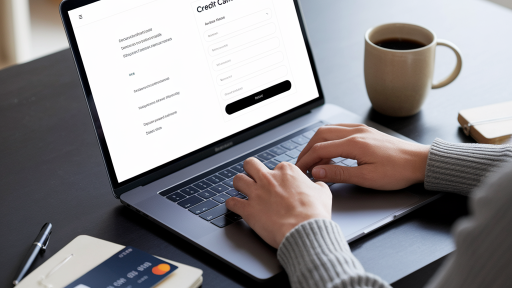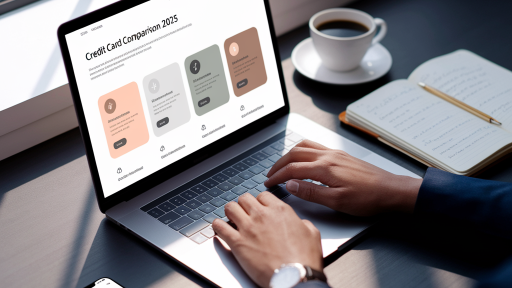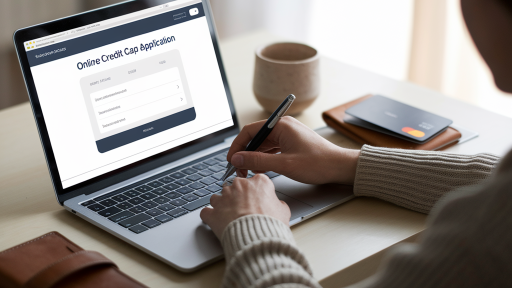Facing the digital world with a less-than-perfect credit score can feel like trying to open a locked door without a key. You know credit is essential for many of life’s financial steps, but when your history is bruised, even applying for a credit card online can seem like an impossible task. It’s a frustrating cycle: you need credit to build credit, but bad credit makes getting that first tool difficult.
The good news is that the door isn’t permanently locked. There are specific keys designed for this exact situation. Financial institutions understand that people need a second chance, and they have created products specifically to help you rebuild. This guide will walk you through your real, actionable options for securing a credit card online, even when your score is low, and show you how to use it as a powerful tool for your financial recovery.
Understanding “Bad Credit” and Why It Matters
Before diving into the solutions, it’s crucial to understand the problem. The term “bad credit” isn’t just a label; it’s a reflection of your credit history, summarized by a number known as a credit score. This score is a lender’s first impression of your financial reliability.
What Exactly Is a Credit Score?
A credit score is a three-digit number, typically ranging from 300 to 850, that predicts your likelihood of repaying a debt. The two most common scoring models are FICO and VantageScore. While the exact formulas are proprietary, they are heavily influenced by several key factors:
- Payment History (35%): This is the most significant factor. Do you pay your bills on time?
- Amounts Owed (30%): This looks at your total debt and your credit utilization ratio (how much of your available credit you’re using).
- Length of Credit History (15%): A longer history of responsible credit use is generally better.
- New Credit (10%): How many new accounts have you opened recently? Too many can be a red flag.
- Credit Mix (10%): Lenders like to see that you can manage different types of credit (e.g., credit cards, auto loans, mortgages).
Generally, scores are categorized like this:
- Exceptional: 800-850
- Very Good: 740-799
- Good: 670-739
- Fair: 580-669
- Poor/Bad: 300-579
If your score falls into the “Poor” or “Fair” categories, you’re considered to have bad credit.
How a Low Score Impacts Your Credit Card Options
When you apply for a credit card online, the issuer performs a “hard inquiry” on your credit report. A low score signals higher risk to them. Consequently, you’re more likely to face rejections. If you are approved, it will likely be for a card with less favorable terms, such as a very low credit limit, a high annual fee, and a steep Annual Percentage Rate (APR). This is the lender’s way of protecting themselves from the perceived risk of you defaulting on your payments.
Your Primary Options for Online Credit Cards with a Poor Credit History
Despite the challenges, you have several solid pathways to getting a credit card. The key is to apply for the right kind of card—one designed for credit-building rather than premium rewards.
1. Secured Credit Cards: The Top Choice for Rebuilding Credit
For most people with bad credit, a secured credit card is the single best starting point. They are “secured” because you provide a refundable cash deposit upfront. This deposit typically becomes your credit limit. For example, a $300 deposit will give you a $300 credit limit.
This deposit removes the risk for the card issuer. If you fail to pay your bill, they can use your deposit to cover the debt. Because of this, secured cards have some of the highest approval rates available. You use it just like a regular credit card for purchases, and you must make monthly payments. Making consistent, on-time payments is what builds your positive credit history.
What to Look For in a Secured Card:
- Reports to All Three Bureaus: Ensure the card issuer reports your payment activity to Equifax, Experian, and TransUnion. This is non-negotiable for credit building.
- Low Fees: Look for a card with a low (or no) annual fee and no hidden “processing” or “application” fees.
- Path to Graduation: The best secured cards will periodically review your account. After several months of responsible use, they may refund your deposit and “graduate” you to an unsecured card, often with a higher credit limit.
2. Unsecured Credit Cards for Bad Credit: Higher Risk, Higher Cost
An unsecured card doesn’t require a security deposit, which can be appealing if you don’t have the cash for one. However, these cards are much riskier for lenders, and they pass that risk onto you in the form of high costs. Unsecured cards designed for bad credit are notorious for their hefty fees.
You might encounter annual fees, monthly maintenance fees, and one-time processing fees that can eat up a significant portion of your initial, and often very low, credit limit. While they can help build credit if they report to the bureaus, the high cost often makes them a less desirable option than a secured card.
3. Retail Store Cards: An Easier Entry Point?
Retail store cards, which can only be used at a specific chain of stores (like Target, Walmart, or a gas station), often have more lenient approval requirements than major bank cards. This can make them an accessible option for those with poor credit.
However, be cautious. These cards frequently come with extremely high APRs, sometimes exceeding 30%. If you carry a balance, the interest charges can quickly spiral. They are best used for small, planned purchases that you can pay off in full immediately. Some store cards are “co-branded” with Visa or Mastercard, allowing use anywhere, but these are typically harder to qualify for.
Comparing Your Choices: Secured vs. Unsecured vs. Store Cards
To help you decide, here is a table comparing the key features of each card type aimed at consumers with bad credit.
| Feature | Secured Credit Card | Unsecured Card (for Bad Credit) | Retail Store Card |
|---|---|---|---|
| Security Deposit | Required (e.g., $200 – $500), but refundable. | Not required. | Not required. |
| Approval Odds | Very High | Moderate to Low | High (for in-store version) |
| Typical Fees | Low or no annual fee. | High annual, monthly, and processing fees. | Usually no annual fee, but high late fees. |
| Interest Rate (APR) | Moderate to High | Very High | Extremely High |
| Credit Building Potential | Excellent, if it reports to all 3 bureaus. | Good, but high costs can be a barrier. | Good, but less impactful than a major bank card. |
How to Apply for an Online Credit Card and Maximize Your Approval Odds
Applying strategically can save you from unnecessary credit score dings from rejected applications. Follow these steps for the best results.
Step 1: Check Your Credit Report and Score
Before you apply for anything, you need to know where you stand. You are entitled to a free copy of your credit report from each of the three major bureaus once a year. You can access these through the federally authorized site, AnnualCreditReport.com. Review your reports for any errors that might be dragging down your score and dispute them if necessary.
Step 2: Research and Use Pre-Qualification Tools
Many major card issuers, like Capital One and Discover, offer online pre-qualification or pre-approval tools. These tools perform a “soft inquiry” on your credit, which does not affect your credit score. This is the single best way to see which cards you are likely to be approved for without the risk of a formal application and rejection.
Step 3: Gather Your Information
When you’re ready to apply, have your personal and financial information on hand. This typically includes:
- Full legal name and address
- Social Security Number (SSN) or Individual Taxpayer Identification Number (ITIN)
- Date of birth
- Total annual income (you can often include income from a spouse, or other accessible household income)
- Monthly housing payment (rent or mortgage)
Red Flags to Watch Out For: Avoiding Predatory Offers
Unfortunately, some companies target consumers with bad credit with predatory offers. Be on the lookout for these warning signs:
- “Guaranteed Approval” Claims: Legitimate lenders cannot guarantee approval before you apply. This is a major red flag for a potential scam or a product with outrageously bad terms.
- Excessive, Unclear Fees: If a card’s fee structure is confusing or seems disproportionately high compared to its credit limit, walk away.
- No Reporting to Credit Bureaus: A card that doesn’t report your payments to Equifax, Experian, and TransUnion is useless for building credit. This is a deal-breaker.
- Lack of a Reputable Issuer: Stick with well-known banks and credit unions. Avoid offers from unfamiliar companies you can’t easily research.
Long-Term Strategy: Using Your New Card to Rebuild Your Credit Score
Getting the card is only the first step. The real work—and the real benefit—comes from using it responsibly over time. Your goal is to prove your creditworthiness for better financial products in the future.
Pay Your Bill On Time, Every Time
Payment history is the most important part of your credit score. A single late payment can set your progress back significantly. Set up automatic payments for at least the minimum amount due to ensure you’re never late. It is always best, however, to pay your statement balance in full each month to avoid interest charges.
Keep Your Credit Utilization Low
Your credit utilization ratio is the percentage of your available credit that you’re using. For example, if you have a $300 limit and a $150 balance, your utilization is 50%. Experts recommend keeping this ratio below 30% at all times, and below 10% is even better for your score. On a card with a low limit, this means using it only for small, manageable purchases. According to credit bureau Experian, a low utilization rate shows lenders you can manage credit responsibly without relying on it too heavily.
Monitor Your Progress Regularly
Keep an eye on your credit score through free services provided by many credit card companies or other financial apps. Watching your score rise can be a powerful motivator. Continue to check your full credit reports annually to ensure all information is accurate and to watch your positive payment history grow.
Securing a credit card online when you have bad credit is not just possible; it’s a strategic move toward a healthier financial future. By choosing the right type of card, such as a secured card, and using it responsibly, you are actively rewriting your credit story. It takes patience and discipline, but each on-time payment is a step in the right direction, opening doors to better interest rates, higher credit limits, and greater financial freedom. For more detailed guidance on your rights and how to manage your credit, you can find valuable, unbiased information about getting an online credit card with bad credit from the Consumer Financial Protection Bureau.




